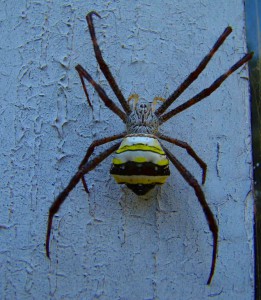
Argiope pulchella (Signature Spider)
The Signature Spider, scientifically known as Argiope pulchella, is a visually striking orb-weaving spider commonly found across South and Southeast Asia. This species is easily identified by the distinctive zigzag silk pattern it weaves into its web—known as a stabilimentum or “signature”—from which it gets its common name. The Signature Spider is often spotted in open woodlands, shrublands, gardens, and the edges of cultivated fields, including within protected ecosystems such as the Great Himalayan National Park.
Physical Description
Argiope pulchella displays a vivid pattern of yellow, black, and white on its abdomen, making it stand out among orb-weavers. Females are typically larger than males and exhibit a prominent cephalothorax and rounded abdomen. Their long legs are banded and often held in an “X” shape when at rest in the web’s center.
Web and Hunting Behavior
This spider constructs large, circular orb webs, often placing them in low vegetation or between branches. The most distinctive feature of the web is the stabilimentum—an X-shaped silk structure at the center—which is believed to serve various functions such as camouflaging the spider, attracting insects, or deterring birds from flying through the web. The Signature Spider is diurnal and typically remains motionless in the web, waiting to ensnare prey like flies, moths, and mosquitoes.
Habitat and Distribution
Argiope pulchella is widespread in tropical and subtropical climates, found in countries like India, Nepal, Sri Lanka, Thailand, and Malaysia. In India, it can be observed in natural parks, farmlands, and even urban gardens. Its presence in the Great Himalayan National Park reflects the park’s rich arthropod diversity.
Argiope anasuja , Family Aranidae
Role in the Ecosystem
As a predator of flying insects, the Signature Spider contributes significantly to controlling pest populations. It plays a crucial role in maintaining ecological balance and serves as an indicator of a healthy, insect-rich habitat.
Human Interaction
Despite its intimidating appearance, Argiope pulchella is harmless to humans. It is non-aggressive and retreats when disturbed. Its bite is rare and generally poses no medical concern.
Conclusion
The Argiope pulchella (Signature Spider) is a fascinating arachnid known for its artistic web patterns and vital ecological role. By contributing to insect population control and showcasing the intricate biodiversity of regions like the Great Himalayan National Park, it deserves appreciation and protection. Observing this spider in its natural habitat can offer a deeper understanding of the delicate balance within forest ecosystems.



